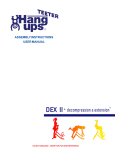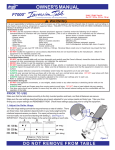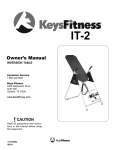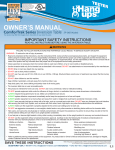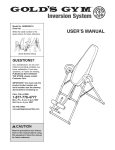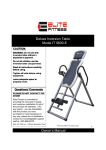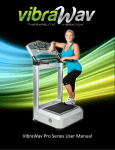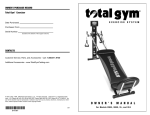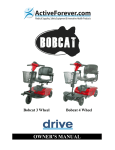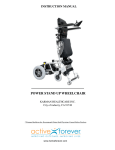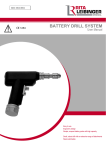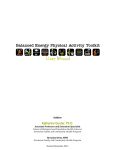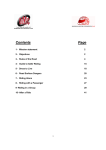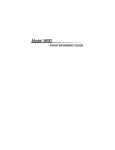Download Teeter Hang Ups Sport EP-550 Instructions
Transcript
R EP-550™/EP-650™ Inversion Table Assembly Instructions R HANG TE 5 YEAR RANT Y W AR S UP TE E www.ActiveForever.com BEFORE YOU BEGIN: Review all steps before beginning assembly and read all precautions before using the inversion table. Carefully adhere to the Assembly Instructions and Owner’s Manual to help ensure safety and product integrity. IMPORTANT SAFETY INSTRUCTIONS READ ALL INSTRUCTIONS BEFORE USING THE INVERSION TABLE. ! WARNING WARNING - To reduce the risk of injury to persons: • Read and understand all the instructions, view the instructional DVD, review all other accompanying documents, and inspect the equipment before using the inversion table. It is your responsibility to familiarize yourself with the proper use of this equipment and the inherent risks of inversion, such as falling on your head or neck, pinching, entrapment, or equipment failure. It is the responsibility of the owner to ensure that all users of the product are fully informed about the proper use of the equipment and all safety precautions. • Close supervision is necessary when the inversion table is used near children, or by or near invalids or disabled persons. • Use the inversion table only for its intended use as described in this manual. DO NOT use attachments not recommended by the manufacturer. • NEVER drop or insert any object into any opening. • DO NOT use or store product outdoors. • DO NOT use if you are over 6 ft 6 in (198 cm) or over 300 lbs. (136 kg). Structural failure could occur or head/neck may impact the floor during inversion. • DO NOT allow children to use this machine. • Keep children, bystanders, and pets away from machine while in use. • Keep body parts, hair, loose clothing and jewelry clear of all moving parts. • The inversion table has no user serviceable parts. • This product is intended for indoor home use only. DO NOT use in any commercial, rental or institutional setting. • DO NOT use the equipment without a licensed physician’s approval and a review of the medical contraindications, as noted in the Owner’s Manual. • Failure to assemble and/or use the equipment as directed may void the manufacturer’s warranty on this product and could result in injury or death. • Choose a level surface for assembling and operating the table. • Follow each step in sequence. DO NOT skip ahead. • Make sure that all fasteners are secure. • ALWAYS test and inspect the table. Make sure the table rotates smoothly to inverted position and back. • ALWAYS replace defective components immediately and/or keep the equipment out of use until repair. FAILURE TO FOLLOW INSTRUCTIONS AND WARNINGS COULD RESULT IN SERIOUS INJURY OR DEATH. SAVE THESE INSTRUCTIONS Items for Assembly Carefully remove the individual parts from the carton. You should have all of the items listed below. If any items are missing or damaged, contact Customer Service at 1-800-847-0143. Items for Assembly Item Numbers A-frame Base Tether Table Bed Assembly Bolts and Nuts Head Pillow (F7-1002) (F5-1007) (EP-1140) (EP-1149) (EP-1105) (EP-1149) (F5-1007) (EP-1140) (F7-1002) Main Shaft with Ankle Lock System Foam Rollers (2) Rubber Plugs (2) (EP-1105) (EP-1120) (F5-1051) (F5-1056) (F5-1051) (F5-1056) (EP-1120) Hand Grips 1/2” (13mm) hex bolts (6) Roller Hinges (2) Wrenches (2) Allen Wrench (F5-1069) (H1-1202) (F5-1064) (F5-1088) (IA-1149) (F5-1088) (H1-1202) (F5-1069) Bolts may be packaged separately or assembled in hand grips (F5-1064) (IA-1149) Before Beginning Table Bed Before reading further, study the drawing below to familiarize yourself with the important components of your new Teeter Hang Ups® inversion table. A-frame Crossbar Rear and Front Ankle Clamps Hand Grip Adjustable Foot Platform Tether Strap Main Shaft Ankle Locking Pin Stability Feet Step 1 Right spreader arms Left Assemble the A-frame Base (F7-1002) and Install the Handles (F5-1069) • Open the A-frame and make sure the spreader arms are locked, rest the A-frame on the floor (Figure 1). The Crossbar is at the front. • Place each Hand Grip (left/right) over the outside edge of the corresponding Hinge Plate (Figure 2). • Insert three 1/2” (13mm) hex bolts (H1-1202) through the hinge plate into each Hand Grip. Use the wrenches provided to tighten the bolts, being careful not to over-tighten. Crossbar back front Figure 1 Figure 2 Step 2 Support Beam Upper Support Arms Attach the Upper Support Arms to the Table Bed (EP-1140) • Before following this step, make sure you have read the orange insert that came attached to the Table Bed. • Place the Table Bed face down on the floor and push down on the Support Beam, so the two holes align evenly with holes at the base of Upper Support Arms (Figure 3). You may have to exert extra pressure to ensure the Support Beam slides over the rubber spacers. • Insert the two bolts (EP-1149) into the open holes. • Fasten each bolt with a nut. • Use the Allen Wrench (IA-1149) to steady the bolts, tighten the nut onto the bolt with the larger wrench (F5-1088) (Figure 4). Repeat with the second bolt. Figure 3 Figure 4 Step 3 Install the Roller Hinges (F5-1064) onto the Table Bed (EP-1140) • For ease-of-assembly, rest the Table Bed against the side of the A-frame (Figure 5). • Open the Cam Locks on each side of the Table Bed (Figure 5A). • With the Pivot Pins facing outward, insert the Roller Hinges into the brackets on each side of the Table Bed. The Roller Hinges must slide between the Cam Locks and the brackets. • Make sure the Roller Hinges are in the same hole setting on both sides. Figure 6 shows the Roller Hinges engaged correctly in setting C. • Push down on the Cam Locks (Figure 6A) to secure the hinges. NOTE: Refer to the Owner’s Manual for an explanation of the hole settings. If you are unsure, use setting C to start. Figure 5 Cam Lock A B C Pivot Pin Figure 5A Figure 6 Figure 6A Step 4 Attach the Table Bed (EP-1140) to the A-frame (F7-1002) • Holding each side near the Roller Hinges, pick up the Table Bed and stand at the front of the A-frame where the Crossbar is located. Lower each Pivot Pin into the A-frame hinge plates one at a time (Figure 7). You may need to push outward on the A-frame in order to slide the second Pivot Pin into the hinge. Figure 8 shows the correct placement of the Pivot Pin into the hinge plate. • Make sure that both Pivot Pins are seated at the base of the slot in the hinge plate. Check to make sure that the self-locking hooks have closed over both Pivot Pins, and the table rotates smoothly (Figure 9). Figure 7 Figure 8 Figure 9 Step 5 Insert the Main Shaft (EP-1120) into the Table Bed (EP-1140) • Loosen the De-rattler knob on the Main Shaft Housing. • With the height adjustment settings on the Main Shaft facing up, slide the end of the Main Shaft into the Main Shaft Housing on the Table Bed. • Pull out the height-selector locking pin to allow the Main Shaft to slide in farther (Figure 10). For the purpose of easy assembly, slide in the Main Shaft and release the pin in the last height setting (Refer to the Owner’s Manual for proper height adjustment before use). • The Main Shaft must rest against the Crossbar of the A-frame (Figure 11). The Crossbar prevents the table De-rattler Knob Main Shaft Housing Height-Selector Locking Pin Crossbar Figure 11 NOTE: The De-rattler knob is an optional accessory that helps prevent a slight shift in the table when you invert. The security of the product is not compromised if you choose not to tighten the knob. Figure 10 from rotating forward when the user steps on the Foot Platform. If the Main Shaft does not rest on the Crossbar as shown in Figure 11 then the Table Bed has been assembled backwards onto the A-frame and this must be corrected before use. Step 6 Install the Front Foam Rollers (F5-1051) • Slide the Foam rollers over each side of the Front Ankle Bar (Figures 12 and 12A). • Figure 12 Figure 12A Insert the black plugs (F5-1056) into each open end of the Front Ankle Bar if they are not already assembled. Step 7 Attach the Tether Strap (F5-1007) to Limit the Degree of Rotation • Hook the clip at the end of the tether strap to the loop at the base of the table bed (Figure 13) to limit your degree of rotation. • Tighten or loosen the strap to restrict or extend your angle of rotation. Attach the Head Pillow • Figure 13 Figure 14 Attach the Head Pillow by securing the Velcro straps through the holes in the Table Bed – the position of the pillow can be adjusted depending on the user (Figure 14). Step 8 Before Use • Test the table by hand for smooth and steady rotation (Figure 15). • Ensure that all fasteners are secure. • Please complete the warranty registration online • For your reference, the serial number can be found on the back of the Table Bed. ! WARNING Read the Owner’s Manual thoroughly before using your Teeter Hang Ups Inversion Table. Improper settings could result in serious injury or death! Figure 15 Adjustments / Maintenance / Storage CHANGING THE ROLLER HINGE SETTING Figure 16 A B C • Stand with your legs on either side of the Main Shaft. • Reach under each Roller Hinge with your index fingers. Use your thumbs to release the locks over the Roller Hinges (See Figure 16). • Lift both sides of the table out of the A-frame at the same time. You may rest the table on the Crossbar of the A-frame. • Unlock the Cam Locks for each Roller Hinge. Change the Roller Hinges to the desired setting (A, B or C) (Figure 17). • Re-lock the Cam Locks. Replace the Roller Hinges into the hinge plates of the A-frame. MAINTENANCE Figure 17 • To clean the Table Bed, wipe down with a damp cloth. Do not use abrasive cleaners. STORING THE INVERSION TABLE • Loosen the De-rattler knob. • Pull the height-selector locking pin and slide the Main Shaft in all the way to the final hole setting. Engage the pin in the storage setting. • Rotate the table opposite from use until the table has turned 180 degrees and rests against the Crossbar on the A-frame. • Pull up on the spreader arms to fold the A-frame (Figure 18). WARNING: This operation may pinch fingers if not done slowly and carefully. ! WARNING Figure 18 Tipping Hazard: For upright storage, leave A-frame open wide enough to remain stable, or secure to the wall to prevent tipping. In households with small children, the table should be stored flat on the floor, not upright. Assembly & User Instructions Conversion Bar for Teeter Hang Ups® Inversion Tables PURPOSE: Some users prefer to use the standard ankle clamps provided with the Teeter Hang Ups Inversion Table. Others prefer to use the Teeter Hang Ups Gravity Boots while inverting. To convert your inversion table for use with Gravity Boots, you must install the Conversion Bar - failure to do so could result in serious injury or death. Please carefully comply with the following instructions: ! WARNING It is your responsibility to familiarize yourself with the proper use of the equipment and the inherent risks of inversion, such as falling on your head or neck, pinching, entrapment or equipment failure. FAILURE TO FOLLOW INSTRUCTIONS OR HEED WARNINGS COULD RESULT IN SERIOUS INJURY OR DEATH. Restrictions on Use • DO NOT attempt to use the Conversion Bar with any other inversion table that is not designed specifically to be adapted with the Conversion Bar. The Conversion Bar is to be used only with certain Teeter Hang Ups model inversion tables. Check with the manufacturer if you are unsure whether or not your inversion table can be modified with the Conversion Bar. Precautions During Assembly and Before Use •ALWAYS choose a level surface for assembling the Conversion Bar and operating the inversion table. •Follow each step in sequence. DO NOT skip ahead. •DO NOT use until you have thoroughly and carefully read all accompanying documents for the inversion table and Gravity Boots, reviewed product labeling, and inspected the equipment. •ALWAYS test and inspect the Teeter Hang Ups Conversion Bar, Gravity Boots and Inversion Table prior to use. Make sure the table rotates smoothly to inverted position and back. Make sure that all fasteners are secure. •ALWAYS replace defective components immediately and/or keep the equipment out of use until repair. Precautions During Use • ALWAYS wear the Gravity Boots when using the Conversion Bar, making sure the Gravity Boots are fastened securely around the ankles and checking that the Gravity Boot Hooks are fitted properly around the Conversion Bar. PRE-ASSEMBLY BEFORE YOU BEGIN: These instructions will guide you in properly assembling and using the unit. Please review all the steps before beginning assembly. Carefully adhere to these instructions to help ensure user safety and product integrity. ASSEMBLY Step One: Remove the Rear Bar • Remove a black plug and one rear foam ankle clamp with backing from the same side of the rear bar (Figure 1). • Remove the nut and bolt; slide the rear bar out from the main shaft. Keep the nut and bolt in case you want to re-attach the ankle clamps in the future. Step Two: Remove the Front Ankle Clamps • Remove the bolt that holds the retainer spring attached to the front ankle clamp (Figure 2). *Keep the bolt and nut for use in Step Three. • Pull up on the locking pin and remove the front ankle clamp assembly and spring. Figure 1 Step Three: Install the Conversion Bar • Insert the Conversion Bar into the ankle clamp housing. • Attach the Conversion Bar by inserting the bolt removed in Step Two through the holes located at the front of the ankle clamp housing underneath the T-Pin (Figure 3). • Tighten the nut and bolt with the wrenches provided with your inversion table. • With the Conversion Bar in place, you may choose to remove the locking pin by unscrewing its base. Be sure to keep it in case you want to re-attach the ankle clamps in the future. Figure 2 ! WARNING Failure to assemble the Conversion Bar properly could result in serious injury or death! Figure 3 PRIOR TO USE Review all product support materials with the Teeter Hang Ups Gravity Boots and Inversion Table before inverting with the Teeter Hang Ups Conversion Bar. 1. Preparing the Inversion Table • Confirm that the Main Shaft is adjusted to your proper height setting. • Adjust the Ankle Comfort Dial (up or down) to ensure the hooks are securly hooked to the Conversion Bar with the bar touching or nearly touching the base of the hook while the feet rest flat on the Ankle Comfort Dial. 2. Mounting • While facing away from the table with your legs positioned on either side of the Main Shaft, lift one foot so that Gravity Boot Hook on the boot wraps around the Conversion Bar. • Slide the hook along the Conversion Bar until the foot is able to rest flat on the Ankle Comfort Dial (Figure 4). Figure 4 Gravity Boot Hooks Conversion Bar Ankle Comfort Dial ! WARNING Setting the Ankle Comfort Dial so that the hooks are not securely around the bar could cause you to fall during inversion, resulting in serious injury or death! RE-ASSEMBLING THE ANKLE CLAMPS To re-assemble the Ankle Clamps - reverse the process • Remove the black end cap from the back of the ankle clamp housing (Figure 5). • Follow Step Three through Step One, reversing the installation process to remove the Conversion Bar and re-assemble the rear and front ankle clamp assemblies (Figures 6 & 7). • IMPORTANT FOR FRONT ANKLE CLAMP ASSEMBLY: - Make sure that the holes in the front ankle clamp assembly are on top (facing the same side as the locking pin). - When inserting the bolt into the holes in the housing, be sure to slide Bottom of Ankle Housing the bolt through the loops at the end of the spring and security cable. You may need to use needle nose pliers to pull and align the spring loop and cable with the bolt. - Fasten securely with the nut. Test the installation of the front ankle Spring and Cables clamps to ensure there is spring-loaded tension. - Replace the black end cap on the back of the ankle clamp housing. • If you removed the locking pin when you installed the Conversion Bar, you MUST replace it securely before using the ankle clamp assembly. Use channel locks or vise grips to ensure that the locking pin is fully tightened. You may want to wrap the base of the locking pin with a cloth to prevent cosmetic scarring when tightening. Black End Cap Figure 5 Figure 6 ! WARNING Failure to properly re-assemble the ankle clamps, including the T-Pin, could cause serious injury or death! Test the locking function of the ankle clamp assembly prior to use. Black End Cap Figure 7 DO NOT DISCARD - KEEP FOR FUTURE REFERENCE Teeter Hang Ups® is a registered trademark of Teeter © COPYRIGHT 2011, Teeter.. LB-1003 0511-4 This product is Listed by Underwriters Laboratories Inc. Representative samples of this product have been evaluated by UL and meet applicable safety standards. RATED 1 This product is Listed by Underwriters Laboratories Inc. Representative samples of this product have been evaluated by UL and meet applicable safety standards. R This product is Listed by Underwriters Laboratories Inc. Representative samples of this product have been evaluated by UL and meet applicable safety standards. OWNER’S MANUAL EP-550™/EP-650™ Inversion Table IMPORTANT SAFETY INSTRUCTIONS This product is Listed by Underwriters Laboratories Inc. Representative samples of this product have been evaluated by UL and meet applicable safety standards. READ ALL INSTRUCTIONS BEFORE USING THE INVERSION TABLE. ! WARNING FAILURE TO FOLLOW INSTRUCTIONS AND WARNINGS COULD RESULT IN SERIOUS INJURY OR DEATH. WARNING - To reduce the risk of injury to persons: • Read and understand all the instructions, view the instructional video, review all other accompanying documents, and inspect the equipment before using the inversion table. It is your responsibility to familiarize yourself with the proper use of this equipment and the inherent risks of inversion, such as falling on your head or neck, pinching, entrapment, or equipment failure. It is the responsibility of the owner to ensure that all users of the product are fully informed about the proper use of the equipment and all safety precautions. • Close supervision is necessary when the inversion table is used near children, or by or near invalids or disabled persons. • Use the inversion table only for its intended use as described in this manual. DO NOT use attachments not recommended by the manufacturer. • NEVER drop or insert any object into any opening. • DO NOT use or store product outdoors. • DO NOT use if you are over 6 ft 6 in (198 cm) or over 300 lbs. (136 kg). Structural failure could occur or head/neck may impact the floor during inversion. • DO NOT allow children to use this machine. • Keep children, bystanders, and pets away from machine while in use. • Keep body parts, hair, loose clothing and jewelry clear of all moving parts. • The inversion table has no user serviceable parts. • This product is intended for home use only. DO NOT use in any commercial, rental or institutional setting. • DO NOT operate equipment while under the influence of drugs, alcohol, or medication that may cause drowsiness or disorientation. • ALWAYS inspect the equipment prior to use. Make sure all fasteners are secure. • ALWAYS replace defective components immediately and/or keep the equipment out of use until repair. • ALWAYS position equipment on a level surface and away from water or ledges that could lead to accidental immersion or falls. • ALWAYS wear securely tied lace-up shoes with a flat sole, such as a normal tennis style shoe. DO NOT wear any footwear that could interfere with securing the Ankle Lock System, such as shoes with thick soles, boots, high-tops or any shoe that extends above the anklebone. • ALWAYS make sure the equipment is properly adjusted to the correct user settings prior to each use. • DO NOT use aggressive movements, or use weights, elastic bands or any other exercise or stretching device while on the inversion table. • New users, and users who are physically or mentally compromised, will require the assistance of a partner to ensure they are able to find the correct balance setting and can return to an upright position unassisted. • If you feel pain or become light-headed or dizzy while inverting, immediately return to the upright position for recovery and eventual dismount. • DO NOT use the equipment without a licensed physician’s approval. Carefully review the following list of medical contraindications for inversion with your licensed physician: (This is not an exhaustive list, it is intended only for reference) · Middle ear infection · Glaucoma · Heart or circulatory disorders · Bone weakness (osteoporosis) · Extreme obesity · Retinal detachment · Spinal injury · Recent or unhealed fractures · Pregnancy · Conjunctivitis · Cerebral sclerosis · Medullary pins · Hiatal hernia · High blood pressure · Acutely swollen joints · Surgically implanted orthopedic supports · Ventral hernia · Hypertension · Recent stroke or transient · Use of anticoagulants ischemic attack (including high doses of aspirin) • Refer to additional warning notices posted on the equipment. If a product label or Owner’s Manual should become lost, damaged or illegible, contact Customer Service for replacement. SAVE THESE INSTRUCTIONS EP-2010 0611-3 BEFORE YOU INVERT make sure that the inversion table rotates smoothly to the fully inverted position and back, and that all fasteners are secure. Make sure the user settings described below are properly adjusted for your unique needs and body type. Take your time finding your proper settings and remember them. Check these settings every time prior to using the equipment. Roller Hinge Selection Per User Weight Roller Hinge: Find Your Setting The Roller Hinge controls the responsiveness or rate of rotation. There are three holes; the hole selection depends both on your body weight and the rotational responsiveness you desire (diagram above right). For users just learning to use the inversion table, we recommend starting with Setting C (Figure 1). IMPORTANT: Set the Roller Hinges in the same hole setting on each side. Height Setting: Adjust the Main Shaft The height settings are labeled on the Main Shaft in both inches and centimeters. • Loosen the De-Rattler Knob. • Pull out the Height-Selector Locking Pin with your right hand while sliding the Main Shaft with your left (Figure 2). • Slide the Main Shaft until the last setting you can read is one inch greater than your height. e.g. If you’re 5’10” (178 cm) the last numbers you’ll be able to read will be 5’11” (180 cm). NOTE: The best height setting for you will depend on your weight distribution and could vary one or two inches on either side of your actual height. Starting at one or two inches more than your height will help to ensure that the rotation of the table is not too fast. • Release the Height-Selector Locking Pin so that it fully engages in a hole. Re-tighten the De-Rattler Knob (optional). ABC Figure 1 Angle Tether: Adjust to Desired Angle For first time users, attach the Angle Tether to help control your angle of rotation (Figure 3). You can increase the angle of rotation allowed by the Angle Tether as you become more comfortable using the table, or remove it all together for full inversion. Figure 2 Ankle Comfort Dial: Find Your Setting The Ankle Comfort Dial can rotate into a High or Low setting (Figure 4). There is a one inch height difference between the settings. The setting you select will vary by the type of shoes you wear and your ankle type. Try inverting in both settings to determine which one is most comfortable for you. The Ankle Comfort Dial should be set so the ankle clamps are secure around the smallest part of the ankles (with minimal distance between the ankle clamp and the top of your foot); this will reduce sliding on the Table Bed while inverted. Prepare to Mount • ALWAYS wear securely tied, lace up shoes with a flat sole, such as a tennis shoe. • DO NOT wear shoes with thick soles, boots, high-tops or any shoe that extends above the ankle bone, as this type of footwear could interfere with properly securing your ankles. Figure 3 Figure 4 R 1.2 Securing Your Ankles Figure 5 Figure 6 Figure 7 Figure 8 • Stand with your back to the Table Bed - do not use the inversion table face-down. • Step over the Main Shaft, placing your feet on the floor on either side. To balance yourself, rest only your lower body against the Table Bed as you slide one ankle at a time between the ankle clamps onto the Ankle Comfort Dial. Be sure to slide your ankle in from the side (Figure 5); DO NOT insert your foot through the ankle clamps as you would slide your foot into a shoe. Your feet should always be either on the floor or on the Ankle Comfort Dial; never use any other part of the inversion table as a step (Figure 6 and 7). • Press your ankles back firmly against the rear ankle clamps. • Rotate the top of the rear clamps slightly inward toward your ankles, this will increase your comfort while inverting. • Pull the T-Pin Lock out to allow the front ankle clamps to snap closed against your ankles (Figure 8). Make sure your pant legs do not interfere with obtaining a secure closure. • Adjust the front ankle clamps to make sure both the front and rear ankle clamps are snug against your ankles. Release the T-Pin Lock so that it fully engages a hole setting (Figure 9). • If the T-Pin Lock does not automatically engage in a hole (Figure 10), push the front ankle clamps inward until the pin engages fully in the next tightest hole setting. Verify that no part of your footwear or garments touch or interfere with the T-Pin Lock in any way during inversion. • Use the concept of HEAR, FEEL, SEE every time you secure your ankles: HEAR the Locking Pin click into place; FEEL the Locking Pin to make sure it is fully engaged in a hole setting; SEE that there is NO space between the Locking Pin and its base. ! WARNING DO NOT lean your upper body against the Table Bed before securing your ankles— FAILURE to engage the Ankle Lock System fully could result in serious injury or death! DO NOT deviate from these instructions. Test Your Balance Setting Figure 9 The inversion table is sensitively balanced, and it responds to very small changes in weight distribution. As a result, you must always test to make sure you have the correct height setting. Ensure that there is clearance to rotate in front, above and behind you. To begin, rest your head on the bed and slowly place your arms on your chest. • If your head is lower than your feet, lengthen the height setting by one hole and test again. • If your feet do not move at all, shorten the height setting by one hole and test again. • If the table comes to rest with your feet lifted a few inches off the A-frame, then you have found the correct balance setting (Figure 11). This is an important step - spend the time needed to find your correct balance setting. Your setting should remain the same as long as your weight does not fluctuate substantially. Figure 10 ! WARNING For your first few inversion sessions, ask a spotter to assist you until you are comfortable with the operation of the inversion table. Figure 11 R 1.3 Inverting When correctly balanced, the table will rotate in response to simple arm movements. To invert, lift your arms overhead slowly and to return upright, bring your arms back to your sides. Your arms provide the weight needed to rotate the table. (Figure 12). To ensure the inversion table does not rotate too far, too quickly: • Set the Roller Hinges to Setting “C” (as explained on pg.2); • Attach the Angle Tether to the underside of the table and test to maximum rotation; • Raise one arm at a time, and do so very slowly (the faster you move, the faster the inversion table will rotate). Figure 12 Returning Upright To return to the upright position, put your arms at your sides. Since your body may have lengthened or shifted on the Table Bed during inversion, you may need to bend your knees to shift your body weight to the foot side of the pivot point. DO NOT lift your head or try to sit up (Figure 13). Full Inversion Definition: Hanging completely upside down by your ankles with your back free from the table. DO NOT attempt this step until you are comfortable with partial inversion. Figure 13 ! WARNING To reduce tipping hazard, confine all inverted activities to smooth movements. Aggressive exercises that involve vigorous body movement can cause the table to tip over, resulting in serious injury or death! • Disconnect the AngleTether. • Set the Roller Hinges in the top hole setting “A” if you want the table to “lock” firmly while inverted. If you are 220 lbs (100 kg) or more, set the Roller Hinges in the “B” hole setting. • From a balanced position on the table, slowly raise both hands over your head to begin rotation. You may need to assist the last few degrees of rotation by pushing on the floor or A-frame until the table pulls away from your back (Figure 14). In your correct balance setting, your weight will keep the table “locked” in this position until you are ready to return upright. To Release from the Inverted “Locked” Position: • Place one hand on the top of the Table Bed behind your head and place the other hand on the base of the A-frame in front of you. • Pull both hands together (Figure 15). This will rotate the table out of the “locked” position. Slowly move your arms and elbows to your sides to complete the rotation. USE CAUTION: Elbows protruding over the sides of the Table Bed could get pinched between the A-frame and the Table Bed as you return upright (Figure 16). Figure 14 Figure 15 ! WARNING It is your responsibility to familiarize yourself with the proper use of the equipment and the inherent risks of inversion, such as falling on your head or neck, pinching, entrapment or equipment failure. DO NOT use the inversion table until you have thoroughly and carefully read the Owner’s Manual, reviewed all accompanying documents and inspected the equipment. ALWAYS test and inspect the equipment for smooth operation prior to each use. R 1.4 QUESTIONS? USA: 1-800-847-0143 International: +1-242-362-1001 4 Figure 16 Teeter Hang Ups® Gravity Boots are designed to be used with the following Teeter Hang Ups products: Teeter Hang Ups EZ-Up Inversion & Chin-Up Rack: ™ Gravity Boots can be used with the EZ-Up™ Inversion & Chin-Up Rack, a double-bar system that secures to a standard wood door frame. Quick-disconnect locking brackets allow the rack to be installed or removed in less than 5-seconds and do not interfere with normal use of the door. EZ-Up Inversion & Chin-Up Rack Teeter Hang Ups Inversion Table: Gravity Boots are an optional upgrade for use with Teeter Inversion Tables equipped with the T-Pin Ankle Lock System. These tables can be converted with a Conversion Bar* for use with Gravity Boots, providing maximum comfort and support for the ankle. Inversion Table Larger style Gravity Boots XL are also available from Teeter Hang Ups. For information about the Teeter Hang Ups® 5-year warranty, or if you have any problems assembling the equipment or questions about its use, please contact Customer Service at the appropriate location below: USA & Canada: Teeter Toll Free (Phone) 800-847-0143 (Fax) 800-847-0188 International: Inversion International, Ltd. (Phone) +1-242-362-1001 (Fax) +1-242-362-1002 ! WARNING It is your responsibility to familiarize yourself with the proper use of the equipment and the inherent risks of inversion, such as falling on your head or neck, pinching, entrapment or equipment failure. FAILURE TO FOLLOW INSTRUCTIONS OR HEED WARNINGS COULD RESULT IN SERIOUS INJURY OR DEATH. Restrictions on Use • DO NOT use the equipment without a licensed physician’s approval. Carefully review the following list of medical contraindications for inversion with your licensed physician: (This is not an exhaustive list, it is intended only for reference) Pregnancy; Hiatal Hernia, Ventral Hernia; Glaucoma, retinal detachment or conjunctivitis; High blood pressure, hypertension, recent stroke or transient ischemic attack; Heart or circulatory disorders; Spinal injury, Cerebral Sclerosis, and acutely swollen joints; Bone weakness (osteoporosis), recent and/or unhealed fractures, medullary pins, and surgically implanted orthopedic supports; The use of anticoagulants, including high doses of Aspirin; Middle ear infection; Extreme obesity. • DO NOT use with the EZ-Up Inversion & Chin-Up Rack if you are over 250 lbs (113.6 kg). DO NOT use with converted Teeter Hang Ups Inversion Tables if you are over 300 lbs. (136 kg) or 6ft 6in (198 cm). Structural failure could occur or head/neck may impact the floor during inversion. • DO NOT modify the equipment or use accessory attachments that are not recommended by the manufacturer. Utilize the equipment for its intended purpose only. • We recommend only using the Gravity Boots with properly installed and tested Teeter Hang Ups products, which are designed specifically for inversion and for use with Gravity Boots. • DO NOT use Gravity Boots with the specific models of Teeter Hang Ups Inversion Tables until you have replaced the ankle clamps with the Conversion Bar. • DO NOT use Gravity Boots with a bar that is not secure to at least four times your body weight. Test this by having two persons hang from the bar by the hands at the same time then pull down vigorously. • DO NOT use Gravity Boots with a bar that exceeds 1.25” (3.2 cm) in diameter. The bar must sit loosely at the base of the hook. Bars that are too large will stress the hook and could result in equipment failure. • Not for unsupervised commercial use. Precautions Before Using • DO NOT use until you have thoroughly and carefully read this booklet, reviewed product labeling, and inspected the equipment. • NEVER allow children to use the equipment unsupervised. • DO NOT operate equipment while under the influence of drugs, alcohol, or medication that may cause drowsiness or disorientation. • ALWAYS inspect the equipment prior to use. Make sure that all fasteners are secure. • ALWAYS replace defective components immediately and/or keep the equipment out of use until repair. Precautions During Use • ALWAYS use a spotter. • DO NOT use aggressive movements, bounce or swing excessively, which may cause the hook to disengage from the bar. • DO NOT use weights, elastic bands or any other stretching device. • DO NOT over-exert your muscles while inverted so you have strength to dismount. R The most comfortable boots on the market! Inversion may help you to: • Relieve back pain • Reduce stress • Decompress spine and joints • Improve circulation • Increase flexibility • Improve posture • Stretch and relax muscles • Recover from high-impact workouts SAVE THESE INSTRUCTIONS Teeter Hang Ups is a registered trademark of Teeter and Inversion International, Ltd. Calf Loops: Why use them? Calf loops are an optional feature that easily detach, so shorter adults can easily invert. Calf loops provide the following benefits: 1. Reduce loads on the ankles and prevent the front edge of the boot from placing uncomfortable pressure on the top of your feet. 2. Offer a hand hold to help you get back up to the bar. User Instructions: Before putting on the boots, first time users should practice and fully understand how to insert the straps and how to snap-lock the buckles. When you are ready to use the boots, determine the correct boot for each leg. The hook of the Right Boot will be marked “Right Boot.” Always put Boots on the correct ankles. Failure to do so may cause discomfort or equipment failure. 1. 2. strap locks 3. Place a 2° bend in the knees, which for most people is more comfortable than inverting with straight legs. A. To Attach Calf Loops: Insert the base of the Calf Loop into the open end of the Boot Hook (Figure A). Make sure you hear the Calf Loop snap into place for secure attachment. Repeat on other boot. To Detach Calf Loops: B. Insert the foot through the calf loop. 3. Press your finger onto the Calf Loop Release Tab (Figure B) and pull loop out of the Boot Hook slot. *Calf Loops must be attached/detached while boots are NOT secured around ankles. Boot Care: No regular maintenance is required, however, for continued smooth use, we recommend keeping buckles latched when not in use. ! WARNING • DO NOT use Gravity Boots with a Bar that is not secure to at least four times your body weight. Test this by having two people hang from the bar at the same time by the hands then pull down vigorously. Repeat this test on the other end of the Bar. • DO NOT use Gravity Boots with a Bar that exceeds 1.25” (3.2 cm) in diameter. The Bar must sit loosely at the base of the hook. Bars that are too large will stress the hook and could result in equipment failure. • ALWAYS use a spotter. • DO NOT engage in excessive bouncing or swinging which could disengage the Boot hooks from the bar. • ALWAYS use slow, controlled movements while inverting. • DO NOT over-exert your muscles while inverted so you have strength to dismount. Wrap the Boots around the ankle with the strap locks toward the front inside of the foot. 4. buckle levers Insert the strap ends into the strap locks for two clicks. At least one full “v-notch” must be visible; DO NOT tighten yet. Rotate the Boot so the hook is positioned at the front of the leg, with the buckle levers on the backside of the leg. Push down on the Boot so it sits on the top of the foot. 5. 6. For proper mounting, inverting, and dismounting, ALWAYS follow the listed WARNINGS & SAFETY INSTRUCTIONS included in this booklet, as well as the instructions for the Rack or Inversion Table with Conversion Bar. Inverting You will use the hooks on the front of the Gravity Boots to suspend yourself with both legs in an inverted position from a securely supported bar. We recommend these Gravity Boots be used only with properly installed and tested Teeter Hang Ups products, which are designed specifically for inversion with Gravity Boots. Follow the specific directions for mounting, inverting, and dismounting that are included with your Teeter Hang Ups EZ-Up™ Inversion & Chin-Up Rack or Inversion Table with Conversion Bar. Note: If you are not using a Teeter Hang Ups product in conjunction with the Teeter Hang Ups Gravity Boots, you will need to determine the proper procedures specific to that particular bar/apparatus for safe mounting, inverting, and dismounting. Having a spotter to assist you for the first few uses of the Gravity Boots is mandatory, and recommended for each time you use the equipment. Stretching Gravity Boots provide a comfortable way to invert and decompress your spine and weight bearing joints. Moving your joints through their range of motion while your muscles are relaxed helps to improve flexibility and promote healthy joints. Crunches & Sit-Ups Inversion offers a method of strengthening abdominal muscles without the addition of compressive loads to your back. Squats Reverse squats utilize your own body weight to resist gravity and are an amazing workout for glutes, hamstrings, and calves. Adjust the straps to fit the ankle. A snug but not tight fit will be most comfortable. Close the buckle levers, making sure they snap shut completely. TO RELEASE: Lift up on the buckle lever and push down on the strap lock tab to release the strap. Note: Invert only as long as you are comfortable. First time users should be careful not to overdo it–this is NOT a no pain, no gain situation! Made in Thailand. ©COPYRIGHT 2011 Teeter and Inversion International, Ltd. International Law Prohibits Any Copying. LB-1002 0911-11























